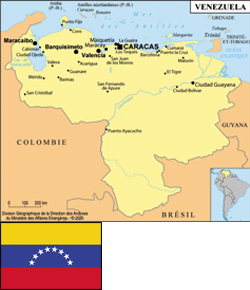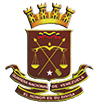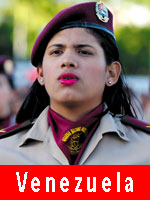
Bolivarian National Guard
|
1937 Ministry of attachment: Ministère de la Défense Workforce: 91 000 General manager: Major-Général Sergio RIVERO MARCANO Address: Comandancia général de la Guardia Nacional Tél.: (58) 0212 406 30 00 Email: contactoguardianacional@gmail.com Website: www.guardia.mil.ve 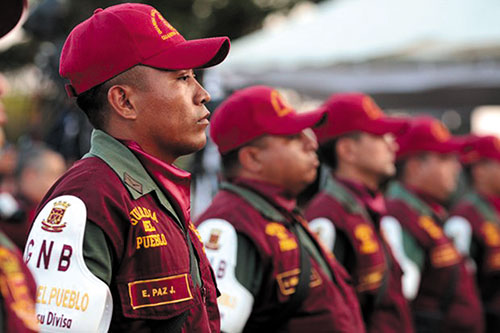
|
History
The Bolivarian National Guard is created in 1937 but the country previously experiments several security forces models. In March 1810, the Caracas supreme Assembly recommends the creation of an armed corps for the Congress guard. On March 9, 1811, a national police company is created. In July of the same year, it takes the rural service to protect the landowners and repress the crimes. Disappeared with the First Republic of Venezuela (1810-1812), it reappears in 1820 before being eliminated again in 1839. From 1841 till 1847, under the general José Antonio Páez’s mandate, a National Police Guard (Guardia Nacional de Policía) is reconstituted in order to ensure the security in rural areas, repress the crime and guard prisoners. At the beginning of the 1930s, Rufino Blanco Fombona, writer and Venezuelan politician, recommends the creation of a Gendarmerie on the Spanish civil Guardia model. From 1935 till 1941, a Spanish military mission, commanded by captain Cecilio Suarez of the Guardia civil, cooperates in the new security force implementation. The Venezuelan National Guard is created on 4th August 1937 by the general-in chief Eleazar López Contreras. In 1945, the National Guard defends the president Isaias Medina Angaritas’ government against a coup d’état. In 1946, it is renamed Cooperation Armed forces. The same year, the National Guard Academy and the guards national School training are created. A cooperation becomes established with FBI and the Chile carabiniere. In the 1950s, the GNB expands its action to the prison protection, the maritime security, the forests protection, the traffic police and the dog units. Twelve regional commands are established. In the 1970s, the GNB is equipped with an Air Service. The April 9, 2008, a bill aims at turning over to the police 70 % of the GNB own skills (fight against the illegal immigration, the drug trafficking, the kidnappings and the armed groups). The opposition opposes itself to this text judged against the Bolivarian National Armed Force organic Law, which fixes in particular the National police privileges. It fears the GNB forward disappearance for the benefit of the considered Police, with the Reserve, as the socialist united Venezuelan Party (PSUV) military wing. The other evoked danger was a putting in competition of both institutions, the National Guard under the Ministry of Defence’s command and the National police force under the Ministry of the Interior and the Justice’s command. The result of December 6, 2015 elections could relaunch this debate.
Organization
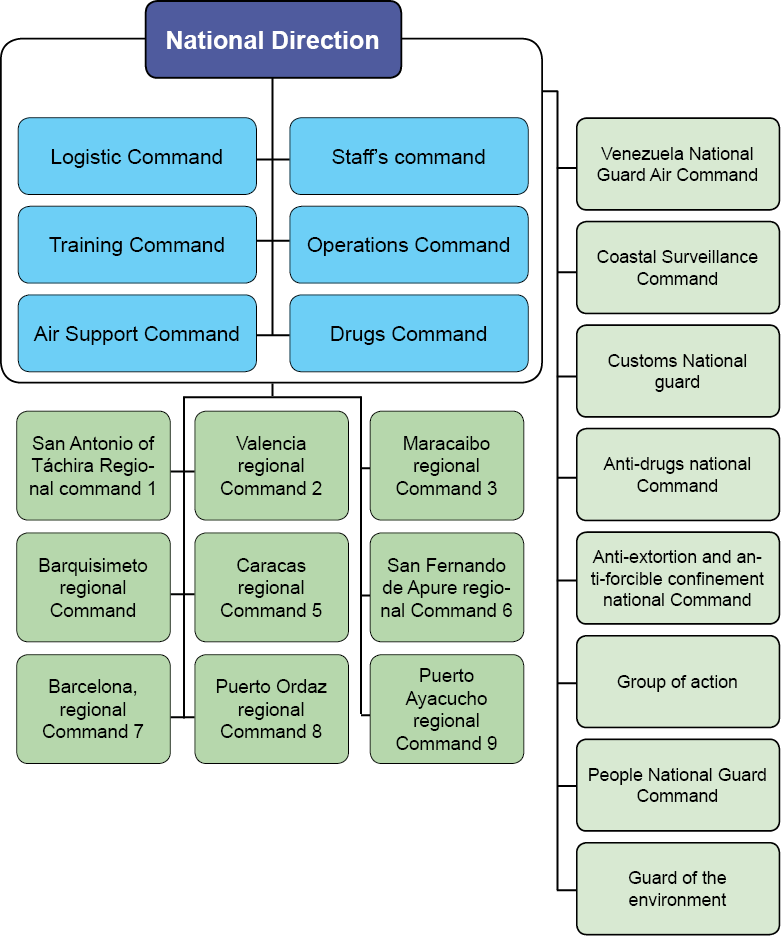
Central Organization
The "Comandancia General" has about ten national Units:
• some logistic and administrative departments,
- a Logistic Command,
- a Staff Command,
- a Training Command,
- several services for social action, accommodation, health, etc.;
• operational departments;
• specialized units.
Territorial organization
The territorial distribution of the units was recently modified in order to provide a more complete cover of the national territory. So, the Bolivarian National Police, which was composed of 9 regional commands (CORE), has from now on 7 interregional Commands ("REDI") and 24 regional commands ("ZODI") under some Generals’ command, and corresponding at the same time to the defence zone division (REDI) and to the political distribution of this Federal State (ZODI) that is including 24 federated States (Confided to elected governors’).
The GNB has recently at its disposal a specific corps: The People Guards Command. The latter gathers 9 000 committed young people, working in the service of the population, following the local police example, in association with the "Bolivarian Militias" (Civil volunteers). The latter are, as for them, under the operational command of the Bolivarian National Armed Forces (FANB Top management).
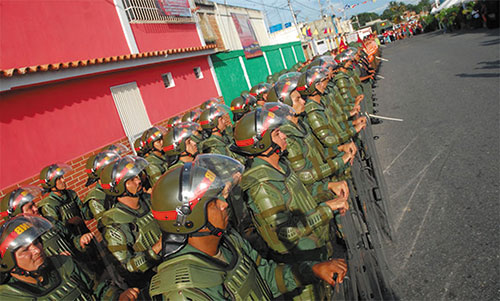
Specialized Training
• Maintenance of law and order (MLO) units articulated around the Capital Zone MLO Unit (4000 to 5000 men). The GNB has a mobilisable reserve of about 24000 men. Those units are equipped in particular with about 140 armoured light vehicles and water spray lance trucks of Chinese manufacturing.
• Venezuela National Guard Air Command (Comando aéreo de la Guardia Nacional de Venezuela) equipped with airplanes and helicopters.
• Coast Guard Command (Comando de Vigilancia Costera).
• Customs National Guard (Resguardo Nacional Aduanero).
• Anti-Drug National Command (comando Nacional Anti-drogas) composed of 23 detachments.
• Anti-Extortion and Anti-forcible confinement Command (Comando Nacional Antiextorsión y Secuestro) composed of 23 regional teams. In its 2013/2019 Action plan, the GNB plans to substitute the CONAS by the CONACDO ("Commando national de la lutte contre la délinquance organisée") with a larger sphere of action.
• Action Group (Grupo de Acciones de Comando).
• People National Guard Command (Comando Nacional Guardia del Pueblo).
• Guard of the environment (Guardería Ambiental).
Missions
According to the national Constitution of 1999 article 329, the National Guard has for main responsibility the internal law and order maintenance of the country. It accumulates three essential functions in the security and the conservation of the territory domains:
• fight against the armed gangs, which crack down on the Colombia bordering zone. In that respect, it plays a key role in the defence of the Nation interests. The borders defence, which gives to the National Guard a major role in the interests of the Nation;
• The environmental protection, which makes the National Guard essential to the Ministry of the Environment because all the resource and the pollution problems management is made with the support of its troops;
• The support for police forces, which allows an effective collaboration between the Ministry of Defence and the Ministry of the Interior. In that respect, the National Guard has a role close to the National Gendarmerie one in France.
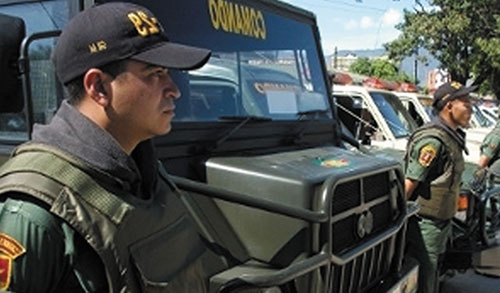
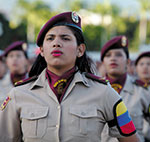 Staff
Staff
The GNB gathers servicemen of the Bolivarian National Armed Force (BNAF), namely approximately 91 000 staffs on a total of 120 000 men and women.
The recruits have to undergo a two years basic training course to the Los Teques "Ramo Verde" School. The officer cadets are then going to go to study during four additional years to the Caracas National Guard Officer Training Academy. Then, the officers will study the third cycle at the Agents College in Caricuao, near Caracas.
Training institutions
• The Caracas National Guard Officer Training Academy.
• The Los Teques "Ramo Verde" school.
Main equipment
• Armament: Kalashnikov AK-103 and 104, Herstal FN, FAL FN, Walther G22, 81 mm mortars.
• Light Vehicles: 4x4 Toyota.
• Transport and Combat Armoured vehicles: Norinco VN-4 4x4 transport of troop and light armoured cars, Unimog UR-416 armoured in wheels.
• Aerials means: helicopters and 50 light planes.
• Nautical means: river and coastal patrols.
Cooperation
Not communicated.
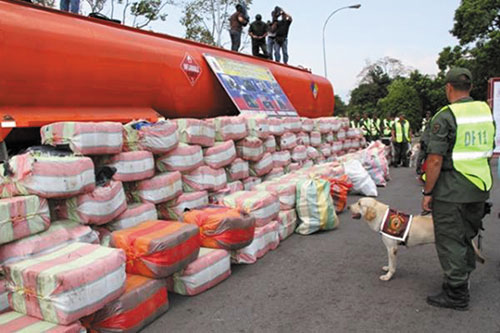
© The iconography was provided by the concerned gendarmeries

